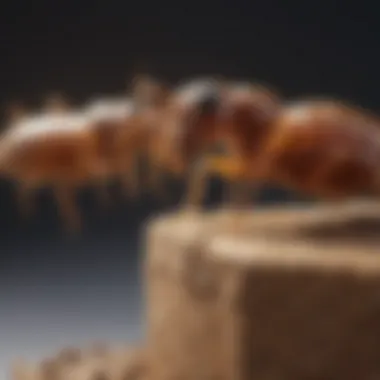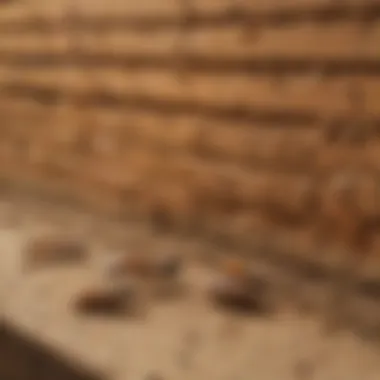Top-Rated Termite Treatments: A Comprehensive Guide


Understanding Pests
Termites are a specific category of pests that pose a significant threat to structures. They feed on cellulose found in wood, paper, and other organic materials. A termite infestation can lead to severe structural damage if not treated promptly. Therefore, understanding these pests is crucial in managing their presence.
Definition of Pests
In a broad context, pests are organisms that harm human interests. Specifically, in residential settings, pests include insects, rodents, and other creatures that interfere with daily life or damage property. Among these, termites are particularly insidious due to their ability to work silently and cause catastrophic damage that is often undetected until substantial harm occurs.
Importance of Pest Identification
Identifying the type of pest is essential for effective treatment. Different pests necessitate distinct approaches. In the case of termites, knowing whether one is dealing with subterranean, drywood, or Formosan termites can impact treatment choices. The correct identification of the species can lead to tailored solutions, ensuring effective eradication.
"Correct pest identification is the foundation of effective pest control."
Prevention Techniques
Preventing a termite infestation is far more effective and less costly than dealing with the aftermath. Proactive measures can safeguard your home.
Home and Garden Preventative Measures
- Reduce Wood-to-Soil Contact: Ensure that wooden structures are not in direct contact with soil. Use concrete or metal to support wood structures.
- Wood Treatment: Apply borate solutions or other treatments to wooden areas which are susceptible to termites.
- Moisture Control: Fix leaking pipes and ensure proper drainage to reduce moisture, which attracts termites.
- Regular Inspections: Conduct periodic checks of wood structures for signs of termites, like mud tubes or hollowed-out wood.
Seasonal Prevention Tips
Termite activity can fluctuate with seasons. It is wise to adjust your prevention strategies according to seasonal behaviors:
- Spring: Inspect your home as termites are most active during this time. Check for signs of swarming.
- Summer: Maintain your gardens and landscaping. Keep shrubs and trees away from the foundation.
- Fall: This is often when termites build mud tubes. Ensure no debris is on the foundation.
- Winter: Even in winter, conduct inspections as termites can still be active in warmer areas of the home.
Eco-Friendly Pest Control Solutions
Sustainability and environmental health are gaining importance in pest control. Exploring eco-friendly solutions can yield effective results while minimizing harm to the ecosystem.
Overview of Sustainable Practices
Sustainable pest control involves methods that result in minimal negative impact. These may include:
- Integrated Pest Management (IPM): Combines biological, cultural, physical, and chemical tools in a way that minimizes economic, health, and environmental risks.
- Organic treatments: Use substances derived from natural sources to combat pest infestations.
Natural Remedies and Their Effectiveness
Several natural approaches exist for termite control, although effectiveness can vary. Some examples include:
- Nematodes: These microscopic worms are effective in hunting down and killing termites.
- Boric acid: A common ingredient in natural pest control products, it disrupts the termite's digestive system.
- Essential oils: Some oils, like clove oil or orange oil, have been shown to be effective against certain pests.
By choosing effective methods of treatment and prevention, homeowners can protect their residences while being mindful of environmental impacts.
Prelims to Termite Treatments
Understanding how to manage termite problems is crucial for homeowners. Termites, often referred to as silent destroyers, can cause significant structural damage without early detection. Therefore, knowledge of termite treatments is a valuable asset for maintaining the integrity of a home. This section introduces readers to essential concepts in termite treatment and encourages proactive measures.
Understanding Termite Behavior
To effectively deal with termites, one must first grasp their behavior. Termites consume cellulose, found in wood and plant matter. They primarily live in colonies, which can range from a few thousand to millions. Most active in warm months, they search for food sources relentlessly. Their ability to go unnoticed until damage becomes severe makes understanding their behavior essential for prevention.
Key points regarding termite behavior include:
- Colony Structure: Termites are social insects, living in colonies with specific roles. Workers gather food, soldiers protect, and reproductives ensure colony growth.
- Feeding Habits: They feed continuously, which can lead to immense damage in a short period. A colony can consume up to 5 grams of wood per day.
- Signs of Infestation: Look for mud tubes, discarded wings, and hollow-sounding wood. Early recognition can prevent costly repairs.
"Identifying termite behavior is the first step in effective control. Knowledge leads to early detection and reduces potential damage."
The Necessity of Effective Termite Control


Having a dependable termite control plan is a must for any homeowner. The potential for damage extends beyond aesthetics; it poses real risks to safety and financial stability. Effective control methods do not just eradicate existing infestations; they work to prevent future problems.
Several benefits highlight the necessity of effective termite control:
- Prevention of Structural Damage: By addressing infestations promptly, homeowners can avoid costly repairs and maintain the property's value.
- Health Considerations: Certain termite treatments may be safer than others, providing peace of mind regarding chemical exposure to family and pets.
- Long-Term Investment: Investing in quality treatments may save money in the long run, as ongoing infestations can lead to severe damage and higher costs over time.
The combination of understanding termite behavior and having a solid control strategy is crucial. It not only mitigates risks but ensures the overall health and safety of a home.
Types of Termite Treatments
Understanding the various types of termite treatments is essential for effective pest management. Each method offers unique benefits and may cater to different situations. By understanding the range of options available, homeowners can make informed decisions based on their specific infestation circumstances. These treatments contribute to both immediate and long-term solutions for termite control, ensuring that any treatment aligns with the homeowner's needs and safety considerations.
Liquid Chemical Treatments
Liquid chemical treatments are often the most common approach in termite eradication. These treatments involve the application of specially formulated insecticides directly into the soil around a home. The primary purpose is to create a barrier that prevents termites from entering the structure. This method is particularly effective against subterranean termites, which are notorious for tunneling and causing significant damage.
Homeowners must consider a few factors when opting for liquid treatments:
- Efficacy: Liquid chemicals are designed to kill termites upon contact or ingestion, making them effective for immediate intervention.
- Duration: Many liquid treatments offer long-lasting protection, with some formulations promising efficacy for several years.
- Professional Application: It is highly recommended that these treatments be administered by certified pest control professionals. They possess the knowledge and tools to ensure effective application and safety.
Baiting Systems
Baiting systems are another effective approach for treating termite infestations. Unlike liquid treatments, baiting systems involve strategically placing bait stations around a property. These stations contain substances designed to attract termites. Once consumed, the bait interferes with the insects’ ability to molt, ultimately leading to their demise.
Homeowners should keep in mind:
- Targeting: Baiting systems can target specific colonies, which may be more effective if the extent of infestation is known.
- Monitoring: Regular checks are crucial. The bait needs replenishing as it may take time for termites to reach the bait stations.
- Environmentally Friendly: Many baiting systems utilize lower concentrations of chemicals, reducing potential environmental risks. This can be appealing for homeowners concerned about the use of harsh pesticides.
Fumigation Processes
Fumigation is a comprehensive treatment method used primarily for severe infestations. This process involves sealing the entire structure and introducing a gas that penetrates all areas, reaching termites in solid wood or hidden spaces.
Key points to consider with fumigation include:
- Effectiveness: Fumigation can eliminate all termites within a structure, making it a swift solution for extensive infestations.
- Preparation: Homeowners must prepare by removing food items and certain household goods to ensure safety.
- Temporary Relocation: The process requires occupants to leave their home for a few days, which may not be suitable for everyone.
Eco-Friendly Solutions
As environmental concerns gain prominence, eco-friendly termite treatments are becoming increasingly popular. These options often utilize natural substances to repel or eliminate termites without harmful chemicals.
Homeowners considering eco-friendly solutions may find:
- Sustainability: Many of these methods are seen as sustainable, addressing pest control without significant environmental impact.
- Diverse Options: Approaches may include the use of nematodes, essential oils, or even borate treatments which have insecticidal properties.
- Safety: They typically pose less risk to pets and humans, making them suitable for families concerned about chemical exposure.
In selecting a treatment, homeowners should consider specific needs, infestation levels, and safety to choose the best method.
Understanding the types of termite treatments available empowers homeowners to take action. Evaluating the options based on their effectiveness, safety, and environmental impact is crucial in the battle against these destructive pests.
Evaluating Treatment Effectiveness
Understanding the effectiveness of termite treatments is crucial for homeowners seeking to rid their properties of these destructive pests. Evaluating treatment effectiveness helps assess not only how well a specific method works but also its longevity and practicality for future infestations. Homeowners must consider factors such as safety, cost, and environmental impact when selecting a treatment. Analysis of effectiveness leads to informed choices that ultimately protect one's investment in their home.
Instant Results vs. Long-Term Solutions
When evaluating treatment methods, one key consideration is the difference between instant results and long-term solutions. Instant results often refer to treatments that eliminate visible termites quickly, such as fumigation or liquid chemicals designed to act fast. While these methods provide an immediate sense of relief, they do not guarantee long-term protection.
In contrast, long-term solutions, like baiting systems or chemical barriers, may take weeks or months to show results. However, they tend to offer better protection against future infestations. It is essential for homeowners to consider their unique needs and the level of infestation. Effective termite management often requires a combination of both instant and long-term approaches to be fully effective.
Factors Influencing Treatment Success
Several factors determine the success of a termite treatment, including:
- Type of Termite: Different species respond uniquely to various treatments. For instance, subterranean termites may require different methods compared to drywood termites.
- Environment: The surroundings of the property, including moisture levels and soil type, can influence treatment effectiveness. Some methods work better in certain environments than others.
- Infestation Level: A high level of infestation may require more aggressive treatment approaches. An initial assessment is vital to choose the right method.
- Application Method: The skills of the pest control professional can significantly impact treatment success. Proper application ensures the treatment penetrates areas where termites are active.
Understanding these factors helps in choosing the right treatment to combat termites effectively. It aids in ensuring that the method selected can withstand possible re-infestations, thereby safeguarding the home. Ultimately, assessing treatment effectiveness enhances decision-making, leading homeowners towards a pest-free future.


Safety Considerations in Termite Treatments
Understanding safety in termite treatments is not merely an add-on; it is paramount. Homeowners must prioritize the health of their family, pets, and the environment while addressing termite issues. The choice of treatment can have lasting implications, and neglecting safety precautions can lead to adverse effects.
Chemical Exposure Risks
Chemical treatments often rely on potent substances designed to eliminate termites effectively. However, these chemicals may pose risks to health. Long-term exposure to such chemicals can lead to various health issues, including respiratory issues, skin irritation, or more severe conditions if ingested.
It is essential for consumers to read safety labels thoroughly and adhere to the recommended safety measures provided by manufacturers.
Homeowners should consider employing professionals who are trained to handle these materials safely. Proper ventilation during and after treatment is critical to reduce inhalation risks. Furthermore, using protective gear, such as gloves and masks, should be mandatory if homeowners opt for DIY methods.
"Chemicals are powerful tools in termite management, but their safety must not be overlooked. Always prioritize your health and environment."
Impacts on Pets and Wildlife
When using any form of pest control, it is vital to consider the effects on pets and surrounding wildlife. Many commonly used insecticides can be toxic to animals. Pets may accidentally ingest these materials or come into contact with treated areas.
To mitigate risks, it’s important to:
- Keep pets indoors during the treatment period and for a recommended duration afterward.
- Observe warning signs on product labels regarding the safety of pets.
- Inform neighbors if treatments may impact shared spaces, potentially endangering local wildlife as well.
In addition, there are eco-friendly treatments available. These alternatives tend to be less harmful to pets and wildlife while still providing effective termite control. Homeowners concerned about pet safety should consider these options as viable solutions for their infestations.
Choosing the Right Treatment
Selecting the correct pest control method is a crucial step in handling termite infestations effectively. Homeowners must evaluate various factors before deciding on a treatment. Understanding the extent of the infestation, the types of termites present, and the specific conditions of the property play significant roles in this process. The right choice can lead to quick eradication and long-term protection from future invasions.
Among the key benefits of choosing the appropriate treatment is the potential for long-term savings. Investing in a less effective method may lead to repeated infestations and higher overall costs. In contrast, a targeted treatment can provide peace of mind by ensuring that termites are handled promptly and thoroughly.
Assessing the Level of Infestation
Determining how severe the termite problem is forms the foundation of a successful treatment plan. Homeowners should look for specific signs of infestation, such as:
- Mud tubes on exterior walls
- Damaged wood, indicating consumption by termites
- Presence of termite frass, which resembles sawdust
- Swarmers, which are winged insects that indicate a mature colony
Once these indicators are identified, a full inspection may be necessary. Professionals can help in evaluating the extent of damage, which informs the treatment approach. In some cases, localized treatments may suffice, but severe infestations might require complete fumigation.
Financial Considerations
The financial aspect of termite treatment cannot be overlooked. Costs can vary significantly based on the method chosen and the level of infestation. Liquid chemical treatments tend to be less expensive upfront, while fumigation and baiting systems might require a larger initial investment.
When calculating treatment costs, it is vital to consider potential hidden expenses. These may include:
- Repair costs for structural damage caused by termites
- Ongoing monitoring expenses if a baiting system is utilized
- Costs associated with follow-up treatments if the initial method fails
To ensure that spending aligns with potential outcomes, homeowners should seek multiple quotes from pest control services. Comparing these estimates can help in understanding the market standard and choosing the best option that fits the budget.
"Choosing the right treatment can greatly impact both the effectiveness of termite control and overall financial expenditure."
Cost Analysis of Termite Treatments
Understanding the costs associated with termite treatments is crucial for homeowners. The financial implications can vary significantly depending on the method chosen, the severity of the infestation, and the particular circumstances of a home. A comprehensive cost analysis helps in planning and budgeting effectively while ensuring the selected treatment is suitable and efficient. By assessing both direct and indirect financial aspects, homeowners can make informed decisions and avoid potential pitfalls.
Comparative Costs of Methods
When evaluating various termite treatment options, it is essential to compare the costs associated with each method. Different treatments have distinct upfront and long-term costs, which can influence a homeowner’s choice. Here are some common methods analyzed in terms of cost:
- Liquid Chemical Treatments: This method usually requires a professional application and may range from several hundred to a few thousand dollars depending on the size of the property and severity of the infestation.
- Baiting Systems: Initial setup costs can be substantial, often ranging from $1,500 to $3,000. However, these systems may lead to lower maintenance costs over time, making them a viable option for some homeowners.
- Fumigation: Although highly effective, fumigation is also the most expensive method. Costs can vary widely, typically starting around $2,500 for small homes and increasing with size and complexity.
- Eco-Friendly Solutions: Chemical alternatives may have lower initial costs but can vary in effectiveness. Homeowners should consider these based on personal values and long-term operational costs.
Understanding these costs helps in determining the most effective and appropriate solution for a given situation.


Hidden Costs to Consider
In addition to the obvious costs, hidden expenses can have a significant impact on the overall budget. It is vital to think carefully about these potential costs to avoid surprises later on. Consider the following hidden costs when analyzing termite treatment options:
- Preparation Costs: Many treatments require preparation work, such as clearing furniture or landscaping adjustments. This can result in additional expenses that may not initially be factored into the treatment estimate.
- Follow-up Treatments: Some methods may require additional follow-up treatments or maintenance visits, adding to the overall cost.
- Property Damage: An ongoing infestation can lead to structural damage over time, resulting in costly repairs that could have been avoided with timely treatment.
- Reevaluation Costs: If initial treatments are ineffective, further assessment and possible reevaluation may be necessary, leading to additional costs.
Preventative Measures Against Termite Infestations
Preventative measures against termite infestations are crucial for homeowners. Termites cause significant damage to structures, often without detection until it is too late. Taking steps to prevent infestations is far more effective, and usually less costly, than dealing with a full-blown invasion. This section outlines essential strategies that homeowners can adopt to safeguard their properties against these destructive pests.
Basic Maintenance Practices
Basic maintenance forms the foundation of effective termite prevention. Regular inspections play a key role. Homeowners should routinely check for signs of termites, such as mud tubes or discarded wings. Maintaining a clean environment also helps; removing wood debris, old tree stumps, and piles of leaves reduces potential nesting sites.
Another important aspect is moisture control. Termites are attracted to damp wood. Fixing leaking pipes, ensuring proper drainage, and utilizing dehumidifiers in basements can lower humidity levels and deter termites. Regularly cleaning gutters to prevent water buildup is also advisable.
- Seek professional inspections annually.
- Use treated wood in construction.
- Repair any cracks in the foundation or walls.
These actions contribute to a comprehensive maintenance routine that not only prevents termites but also improves overall home quality.
Effective Landscaping Techniques
Landscaping has a direct impact on termite prevention. The right techniques can create barriers that deter termites from entering a property. Homeowners should avoid planting trees and shrubs too close to their foundations. This reduces the chance of termites finding a direct path to the home.
Using mulch can be beneficial, but it should be applied judiciously. Cedar mulch is known to repel termites. However, homeowners must ensure that any mulch is kept several inches away from the building's base. Rock or gravel can serve as alternative ground cover that does not provide a food source for termites.
In addition, it helps to elevate wooden structures, such as decks, to minimize ground contact. Ventilation beneath these structures is crucial as well. Adequate air circulation will keep wood dry and less attractive to termites.
Understanding prevention is less about fighting termites directly and more about creating an environment that is inhospitable to them.
Implementing these landscaping techniques alongside maintenance practices results in an effective, multifaceted approach. This helps to protect homes from the threat of infestations over the long term.
Expert Recommendations and Reviews
In this section, we delve into the significance of expert recommendations and reviews, as they play a critical role in shaping informed choices about termite treatments. With the vast pool of products and solutions available today, effectively navigating this realm can be a daunting task for homeowners. Thus, expert insights are invaluable. They offer clear assessments of various methods based on empirical data and real-world applications. This guidance ensures that homeowners can make educated decisions about the best approach for their specific situation.
Industry-Wise Best-rated Products
When evaluating termite treatments, focusing on the best-rated products is fundamental. Industry experts frequently assess and review pest control solutions based on criteria such as effectiveness, safety, and ease of use.
- Termidor: Known for its long-lasting effects, this liquid treatment swiftly eliminates termites and prevents further infestations. Its active ingredient has garnered rave reviews for efficacy in both immediate and long-term control.
- Advance 375A: This baiting system is praised for its selective nature, targeting termites without posing risks to other wildlife. Homeowners appreciate its ease of use and effectiveness in reducing termite populations over time.
- Vikane: A fumigation option that has received high marks from industry professionals. It penetrates structures thoroughly, ensuring a complete elimination of termites in heavily infested areas.
Consumer Feedback and Ratings
Understanding consumer feedback is equally crucial when determining the best termite treatments. Customer reviews often highlight user experiences that can reveal both strengths and weaknesses of a product.
- Many users of Termidor report a noticeable decrease in termite activity shortly after application, supporting its industry acclaim.
- Consumers commonly cite their satisfaction with the Advance 375A bait system due to its low-maintenance nature and effectiveness in deterring new infestations.
- In contrast, some users of Vikane have mentioned concerns about the complexity of the fumigation process, emphasizing the need for professional application.
Overall, compiling these expert recommendations and consumer ratings provides a comprehensive view of the market. Homes facing potential or existing termite issues can substantially benefit from both professional guidance and peer insights. This dual perspective empowers homeowners to take confident steps in protecting their properties from termite damage.
Closing Thoughts on Termite Treatment
The discussion about termite treatments culminates in an understanding of their significant role in maintaining the integrity of our homes. Effective treatment is not just a choice but a necessity for homeowners faced with the risks associated with termite infestations. With increasing awareness and research into pest control methods, insights into treatment approaches, safety measures, and preventative practices provide a comprehensive arsenal against these damaging pests.
Emerging Trends in Termite Control
In the field of termite control, emerging trends reflect a shift toward Integrated Pest Management (IPM). IPM emphasizes a holistic approach, considering not only the immediate extermination of termites but also long-term strategies for preventing future infestations. This method uses a combination of monitoring, baiting, and targeted treatments.
Another trend is the growing interest in organic treatments. As more homeowners seek eco-friendly options, products like borate and nematodes are becoming popular. Using these natural methods aligns with a broader movement towards sustainable living and reduces chemical exposure in home environments.
"The most effective treatments often integrate various approaches, ensuring both immediate impact and future prevention."
The Future of Termite Management
The future of termite management is likely to be shaped by advancements in technology. Innovations such as smart sensors that monitor termite activity in real time will transform proactive approaches to pest control. These devices will allow homeowners to receive alerts, enabling faster responses to infestations before they escalate.
Additionally, biotechnology offers promising solutions. Genetically modified organisms (GMOs) that target specific pest behaviors pose a game-changing opportunity to refine control measures.
As regulations become stricter concerning chemical use, traditional methods may be replaced or modified in favor of safer, more environmental ones. This makes it crucial for homeowners to stay informed about currently recommended practices and products.



